The weather here in Maine has been around the mid-50s to 60s and we have even experienced a few enjoyable nights in the 30s. The humidity hasn’t left us though and this past Wednesday was especially hot and humid. We had a bit of rain the day before and it felt as though summer had returned. It was in the mid 70’s, partly cloudy and extremely humid. I was doing a few things around the house and I spotted a few wild turkeys in the backyard. I went upstairs to see if I could get a better view and upon further investigation, I discovered there was quite a sizable flock.
I had to grab my camera of course and hoped to get a few photographs. I made my way outside, trying to make as little noise as possible and took as many photographs as I could. The turkeys didn’t seem too concerned with me and I started clicking away. Usually, I don’t have such luck and these birds always head for the woods as soon as I get outside. I usually have to settle with taking pictures through the windows. The flock consisted of hens and juveniles and I was hoping they didn’t feel my presence as a territorial threat. I used the fence as a blind, but I’m pretty sure they knew I was there and they still didn’t leave. At one point, the turkeys were only about 20 feet from the fence. The flock spent the whole day here for the most part foraging, preening themselves and enjoying the here and there sun with the passing clouds. We have had many flocks of turkeys come through the property, but never here all day. They stuck to the same pattern all day, after foraging and preening, they would go into the woods and then make their way back out into the lawn. At the end of the day, they made their way back into the woods.
This went on all day and I was able to take many photographs and some video. My lens kept fogging up, because of the humidity. I had to keep wiping my lens frequently, but I think I was able to get a few good shots. In this post, I would like to share these photographs and video with you as well as some information on the wild turkey.
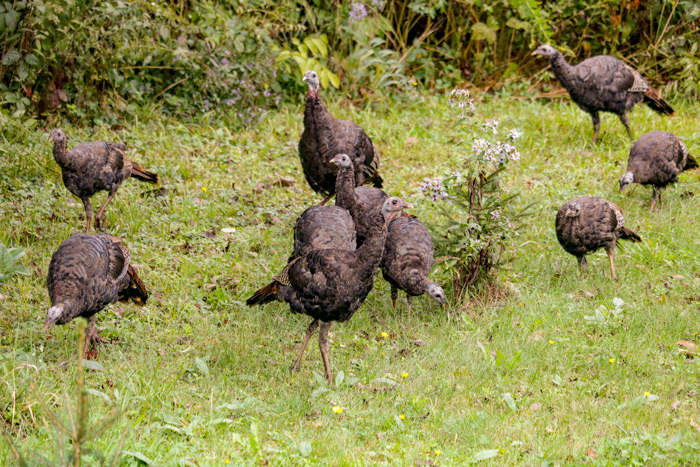
The wild turkey is North America’s largest year-round game bird. They are found in 49 of the 50 states (all except Alaska). They can be seen from southern Canada to southern Mexico.
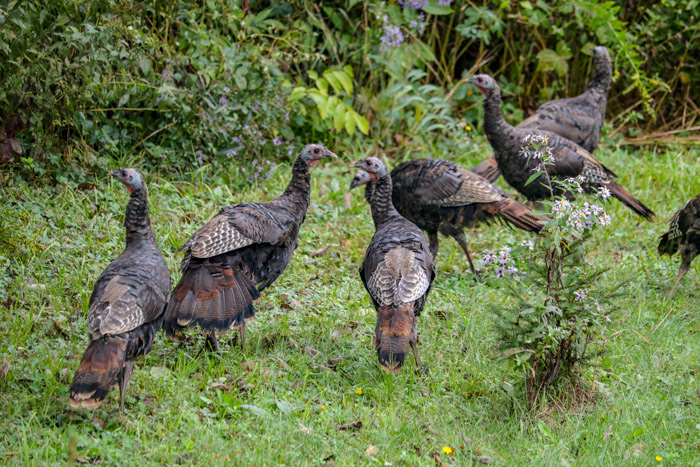
Wild turkeys are very large and plump birds with long legs, wide, rounded tails and a small head on a long, slim neck. Adult males can weigh from 11 to 24 pounds and measure 39–49 inches in length. The adult female is typically much smaller than the males, weighing between 5.5–11 pounds and 30 to 37 inches long.

Wild turkeys have a dark overall bronze-green iridescence to most of their body feathers. The wings are dark and blackish and boldly barred with white. Their rump and tail feathers are broadly tipped with a rusty color or white and the legs are grayish-green. The bare skin of the head and neck will vary in color from red to blue to gray.
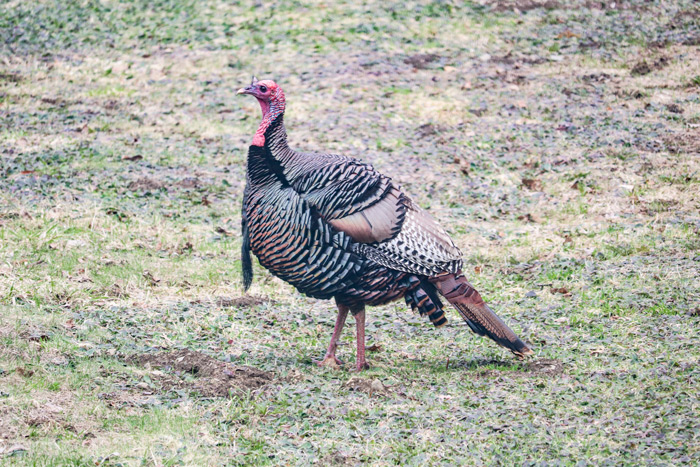
The male’s feathers have areas of red, purple, green, copper, bronze and gold iridescence. Adult male are called toms or gobblers and they have a large, featherless, reddish head, red throat and red wattles on the throat and neck. The head has fleshy growths called caruncles. The long fleshy object over a male’s beak is called a snood. Each foot has three toes in the front, with a shorter, rear-facing toe in back; males have a spur behind each of their lower legs. They will typically have a “beard,” this a tuft of coarse hair consisting of modified feathers and grows from the center of the breast. The juvenile males are called jakes.
Females are called hens and have feathers that are duller overall, in shades of brown and gray. In some populations, females have a beard, but it is usually shorter and thinner than that of the male. A juvenile female is called a jenny.

Wild turkeys prefer mature mixed conifer and hardwood forests especially such as oak (Quercus), hickory (Carya), or beech (Fagus), with varying openings such as pastures, fields, orchards and seasonal marshes. They can be seen along roads and in backyards with woods. They also require grassy openings and hay and pasture lands for raising young.
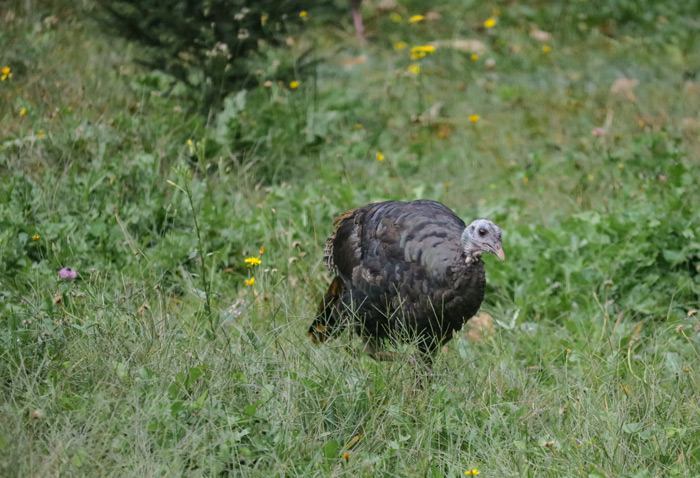
Wild turkeys mostly forage by walking on the ground. These birds travel in flocks and search on the ground for nuts, berries, insects and snails. They often scratch in leaf litter to expose food. They will sometimes climb in shrubs or trees to eat berries. They will forage most actively in the early morning and evening.
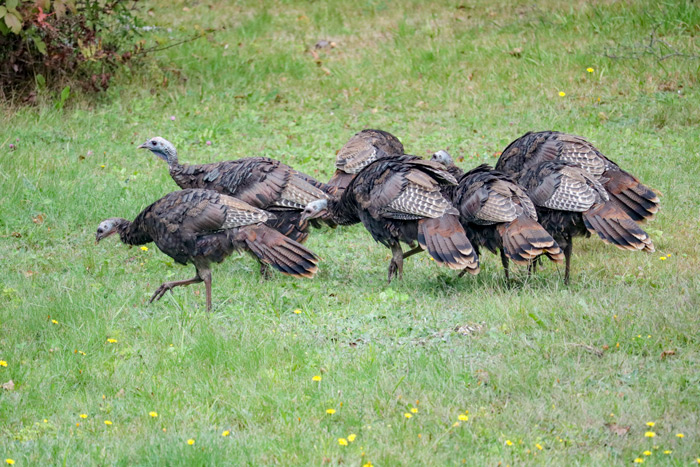
Wild turkeys have excellent eyesight, acute hearing and are good fliers, although they often walk or run from a source of danger. Despite their weight, wild turkeys, unlike the domesticated turkey, are quite agile fliers. In ideal habitats of open woodland or wooded grasslands, they can fly beneath the canopy and find places to perch. They can fly up to 60 miles per hour and a distance of 1 mile. At night, turkeys fly up into trees to roost in groups.

Wild turkeys have many vocalizations, gobbles, clucks, putts, purrs, yelps, cutts, whines, cackles, and kee-kees. In early spring, males older than 1-year-old gobble to announce their presence to females and competing males. The gobble can carry for up to a mile. Males also emit a low-pitched drumming sound. They also produce a sound known as the spit, this is a sharp expulsion of air that comes from an air sack. Hens will yelp to let toms know their location.
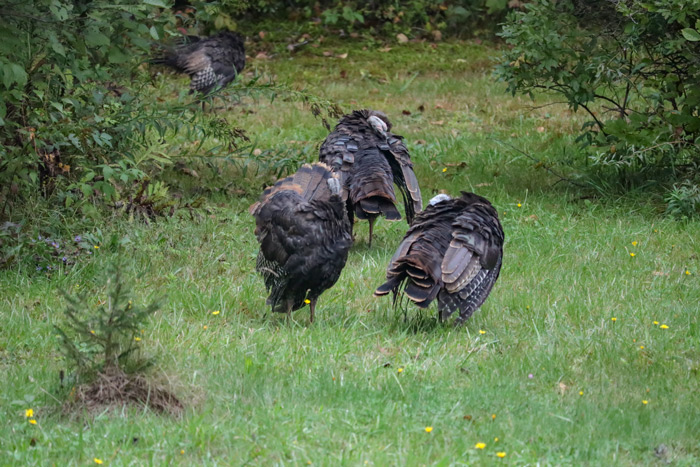
In the early spring, male wild turkeys gather in clearings to perform courtship displays. They will puff up their body feathers, flare their tails into a vertical fan and strut slowly while giving a gobbling call.
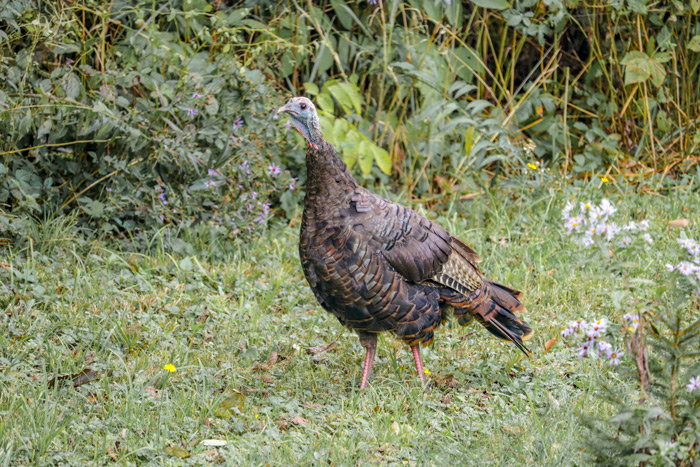
Male wild turkeys are polygamous and will mate with as many hens as they can. They can be seen courting in groups, often with the dominant male gobbling, spreading its tail feathers (strutting), while drumming/booming and spitting. Their heads and necks are colored brilliantly with red, blue and white. The color may change with the turkey’s mood, with a solid white head and neck being the most excited. Courtship begins during the months of March and April, which is when turkeys are also still flocking together in winter areas.
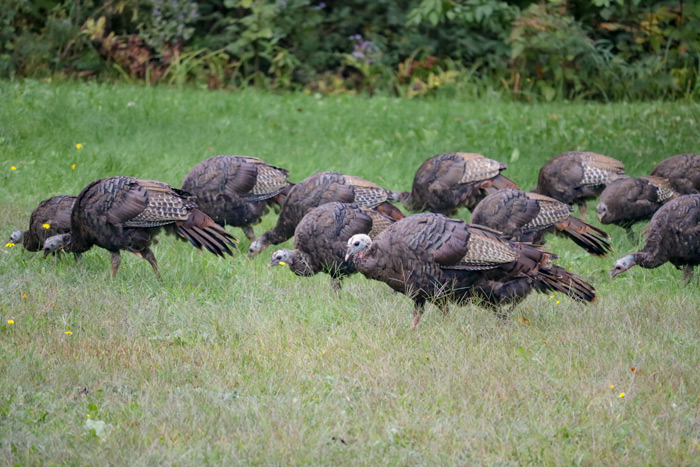
When mating is finished, females will begin to search for nesting sites. Nests are shallow dirt depressions covered with woody vegetation. Hens lay a clutch of 10–14 eggs, usually one per day. The eggs are white to pale buff in color, dotted with reddish brown. The eggs are incubated for at least 28 days. The downy young called poults are precocial and leave the nest in about 12–24 hours.
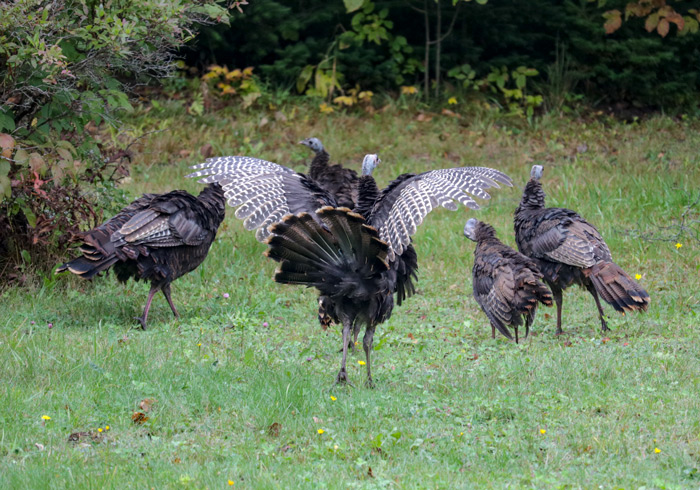
Predators of eggs and nestlings include raccoons (Procyon lotor), Virginia opossums (Didelphis virginiana), striped skunks (Mephitis mephitis), spotted skunks (Spilogale ssp.), gray fox (Urocyon cinereoargenteus), groundhogs (Marmota monax) as well as other rodents. Predators of poults in addition to nestlings and eggs also include several snakes species, including rat snakes (Elaphe ssp.), gopher snakes (Pituophis catenifer) and pinesnakes (Pituophis ssp.). Predators of poults include raptors such as bald eagles (Haliaeetus leucocephalus), barred owl (Strix varia), red-shouldered (Buteo lineatus), red-tailed (Buteo jamaicensis), white-tailed (Geranoaetus albicaudatus) and Harris’s hawks (Parabuteo unicinctus) as well as the Cooper’s hawk (Accipiter cooperii) and broad-winged hawk (Buteo platypterus).
Predators of both adults and poults include coyotes (Canis latrans) gray wolves, (Canis lupus), bobcats (Lynx rufus), cougars (Puma concolor), golden eagles (Aquila chrysaetos) and possibly American black bears (Ursus americanus). In addition to poults, hens and adult-sized fledglings can be vulnerable to predation by great horned owls (Bubo virginianus), northern goshawk (Accipiter gentilis), domestic dogs (Canis lupus familiaris), domestic cats (Felis catus) and the red fox (Vulpes vulpes). Humans have now become the leading predator of adult wild turkeys.
When approached by potential predators, wild turkeys and their poults will usually run away rather than fly away from potential predators. They may also fly short distances if pressed. Sometimes, if cornered, adult turkeys may try to fight off predators. Large male toms can be especially aggressive while defending themselves. When fighting off predators, turkeys may kick with their legs, using the spurs on their back of the legs as a weapon, bite with their beak and ram with their relatively large bodies and may be able to deter predators up to the size of mid-sized mammals. They also have been seen to chase off humans as well. After being hunted out of large parts of their range, wild turkey populations are increasing once again.
Here are a couple of short videos of the visiting wild turkeys:
Resources used for this post:
allaboutbirds.org & audubon.org
Leave a Reply